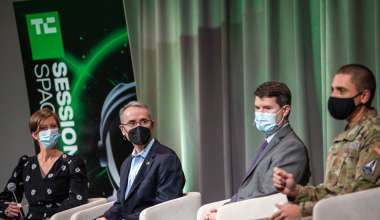While there is increased attention on commercial-, automotive-, and industrial-grade parts for resilient missions and technology developments, the biggest concern is their sensitivity to the natural space radiation environment.
Just how well will these parts fare in an environment they were not tested in or intended for?
Characterizing Radiation Tolerance
As part of its internal research work, Aerospace is characterizing the radiation tolerance of off-the-shelf electronic parts of interest to the space community and publishing the results. Along with other data on thermal, chemical, electrical, and materials properties, the research results will help space users determine whether choosing a commercial part is an opportunity to seize or a risk to avoid.
Along with her colleagues, Dr. Allyson Yarbrough, principal engineer, Electronics and Sensors Division, is leading the way and claims that using automotive-grade parts, in particular, are very much on the forefront of everyone’s mind. “These parts offer attractive capabilities. The challenge is determining how much of the performance, cost, and schedule benefit survives once you test them for environments that they were never intended for,” she said.
She explained that testing being done by many companies, although necessary, is duplicative, time consuming, and costly, eliminating the benefits that made the parts attractive in the first place. In addition, many of the entities that pay for this kind of testing are unwilling, or unable, to share the results due to competitive advantage concerns.
VIDEO: Testing Off-The-Shelf Parts in Space Applications
Sharing Research Data
Aerospace is changing the model by clearing its own off-the-shelf parts research data for release to the broader community and thereby encouraging sharing.
“Aerospace is collaborating with colleagues, industry, and academia to devise options for sharing nonsensitive, off-the-shelf electronic parts, radiation data, and additional information,” said Yarbrough. “Aerospace’s goal is to ‘help all boats rise,’ resulting in customers accomplishing design, manufacture, and deployment of resilient, less-costly systems more rapidly.”
In particular, what makes using automotive parts for space viable is the fact that the Automotive Electronics Council (AEC) has developed standards for quality control and qualification testing that are generally more stringent than those for, say, typical consumer electronics. AEC-qualified parts have emerged at the top of the nonspace-grade list, and Aerospace is coordinating closely with companies that supply electronics to the automotive industry.
In parallel, and leveraging its existing research capabilities, Aerospace is developing several Service Line Offerings. One of these is the Technology Characterization Assessment and Test (TCAT) Service Line, a component of which is dedicated to characterizing commercial electronic parts for high-reliability applications.
“Off-the-shelf parts can and should be used where applicable, recognizing that they will not work for every mission,” Yarbrough said. “The key is to analyze them in light of the specific application and risk tolerance, and guided by agreed-upon ground rules. In the end, it’s all about clearly understanding the customer’s overall mission needs and determining what parts are just good enough to perform that mission reliably, repeatably, and affordably.”








